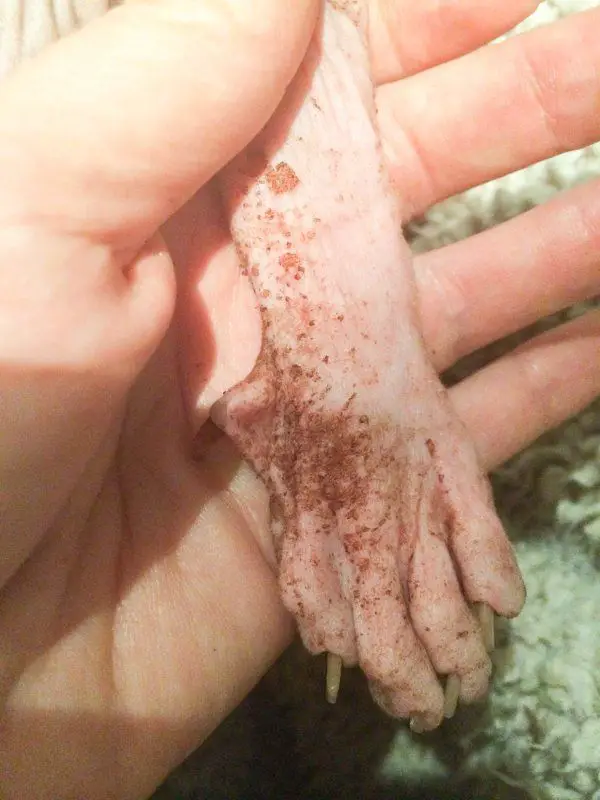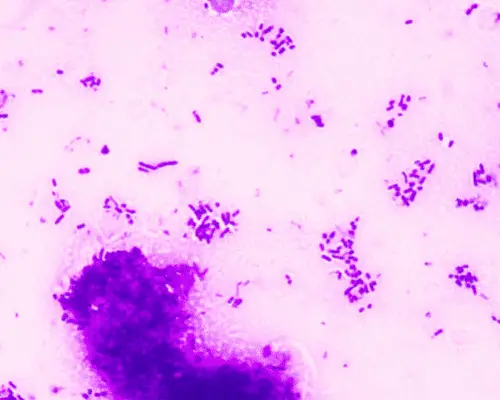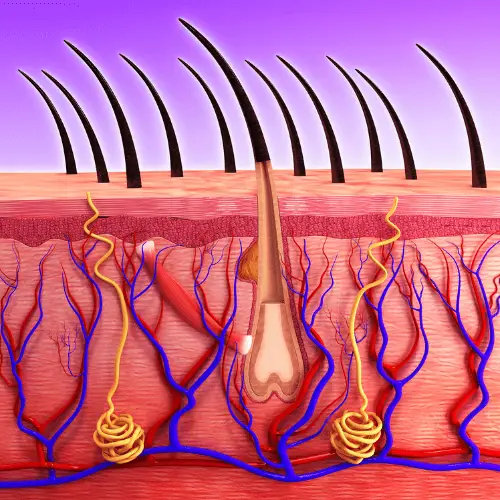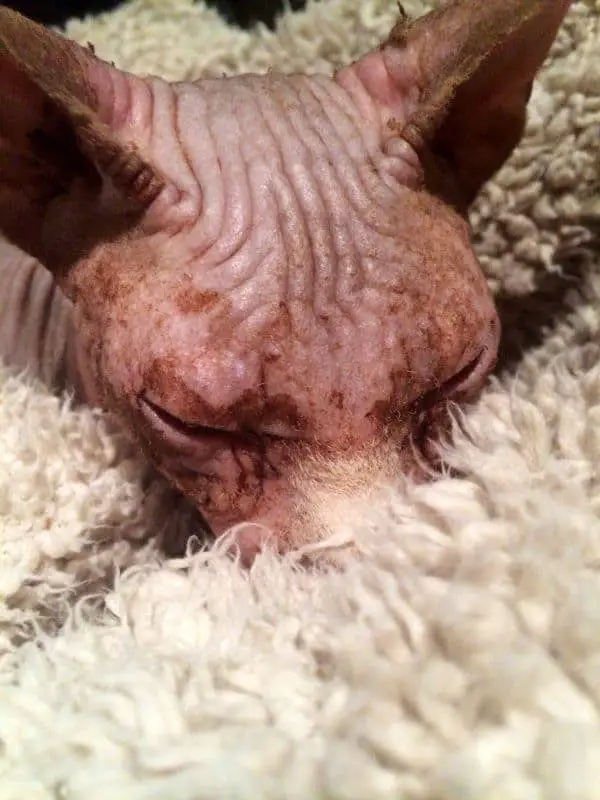This article contains affiliate links, and we may earn a commission at no cost to you if you choose to purchase through these links. I never recommend products that I do not trust or will not advise my veterinary clients and patients to use.
Due to their hairlessness, Sphynx Cats are prone to skin infections caused by yeasts that normally live on the skin, also known as Malassezia Dermatitis. Unfortunately, this infection can sometimes be frustrating to treat, as not all cats cooperate with the treatment. Occasionally, treatment may need to continue for several weeks before the infection resolves.
Malassezia dermatitis in Sphynx cats is caused by an overgrowth of the Malassezia yeast that normally lives on the skin. It causes patches of brown spots on the head, feet, and belly; the lesions are usually mildly itchy. It is commonly treated using medicated shampoo or oral antibiotics and antifungals.
This article aims to arm Sphynx owners with helpful tips to help treat and prevent this pesky skin infection.

What Is Malassezia?
Malassezia, along with other species of fungi and bacteria, live on the outer layer (epidermis) of healthy skin of animals (and humans!) without causing infections. The microorganisms that live on healthy skin are called commensal microorganisms. In fact, by outcompeting disease-causing (also called pathogenic) organisms, these commensals are part of several of the skin’s defense mechanisms against infection.
The commensal organisms on the skin can be compared to the microbiota that lives in the gut of animals and humans and plays an equally important part in the normal functioning of the digestive tract.
Yeasts are single-cell organisms from the same genus as fungi. The main difference between Malassezia and fungal skin infection (like ringworm) is that fungi are multi-cell organisms and reproduce through a different mechanism (producing spores).
Yeasts, as single-cell organisms, reproduce through ‘budding,’ which means that it is exceptionally easy for yeast to multiply at an exponential rate.

What Causes Malassezia Dermatitis?
For a commensal such as Malassezia to cause an infection, there needs to be a disruption in the skin’s normal defenses or a skin barrier breakdown.
Sphynx cats have a substantial population of Malassezia living on their skin. Some studies found that the number of Malassezia on the skin of a sphynx is more than double that of a domestic shorthair cat.
Sphynx cats also tend to have greasy skin. This is not due to the overproduction of skin oil by the sebaceous gland, but rather due to the absence of hair that will wick oil away from the skin surface in furry-coated animals.
Because Malassezia thrives in a lipid-rich environment, the accumulation of sebum on the skin surface and in the skin folds of the Sphynx creates an ideal environment for Malassezia to grow in an uncontrolled manner, disrupting the normal microbiota living on the skin.
This is one of the main reasons why a sphynx with healthy skin should be bathed using a fragrance-free, mild veterinary or baby shampoo every 7-10 days (this may vary from one sphynx to the next). However, Sphynx cats with a skin condition will need more frequent bathing with a medicated shampoo (discussed below). Always check with your vet before making drastic changes to the care of your Sphynx.
Examples of good shampoos to use for your Sphynx’s regular baths (as in non-medicated shampoo) are Burt’s Bees Kitten Shampoo or Cetaphil baby shampoo.

Did you know? One of the first hairless kittens used to develop the sphynx cat breed was called Epidermis. He was bred to a sphynx female called Prune.
What Does Malassezia Dermatitis Look Like?
Malassezia dermatitis often presents as brown or grey scaly spots on the skin. The face, feet, and belly are most commonly affected, and the surrounding and underlying skin may appear slightly red.
Malassezia dermatitis is often itchy, and cats that scratch at their lesions (or chew on their toes) may cause open or bleeding wounds.

What Causes The Skin’s Resistance To Infection To Falter?
An underlying trigger usually results in a decline of the skin’s natural defense mechanisms against the overgrowth of commensal organisms on the skin. A combination of the factors below often leads to an eventual Malassezia dermatitis.
Accumulation Of Sebum On The Skin
Sphynx cats have the same number of hair follicles per skin area as a furry-coated cat does. They, therefore, also have a similar number of sebaceous glands associated with these hair follicles.
In furry animals, the normal production of sebum by these glands is wicked away from the skin to coat the hair shaft, but in the sphynx, it has nowhere to go and accumulates on the skin surface and in skin folds. This creates a moist, greasy and warm environment in which Malassezia thrives.
Any excretion that accumulates on the skin can cause eventual skin irritation and inflammation. Clumps of sebum and exfoliated skin cells that collect in skin folds cause a mild local inflammatory response which, if combined with a massive overgrowth of commensal yeast, will lead to Malassezia dermatitis.
Skin Allergies
Skin allergies can be due to several causes such as environmental (for example, pollen), food intolerance, flea bite allergy, or contact dermatitis (allergy to materials such as plastic food bowls, certain types of metal, or cat litter).
It is extremely difficult to pinpoint exactly what your sphynx may be allergic to with decent accuracy, even with the most comprehensive allergy testing panel, as the results are often ambiguous at best.
If you suspect your sphynx has an allergy, speak to your vet about appropriate medication to help keep your cat comfortable and the possible changes you could make to their environment and diet that may help alleviate the allergic reaction.
Food intolerance is the most common allergy in the sphynx population. Therefore, it is an excellent general rule to aim to feed your sphynx the best quality, minimally processed food from a reputable and quality-checked pet food manufacturer.
Remember that you will have to gradually transition onto a new diet over several days to prevent digestive upset due to a sudden dietary change. In addition, you will need to feed the new diet exclusively (as in no treats or snacks) for at least four weeks to give you sphynx time to respond to the adjustments to see whether the new diet improves her skin condition.
Endocrine Conditions
Endocrine conditions such as diabetes Cushings or hypothyroidism all cause a compromised skin barrier through different mechanisms.
Diabetes is probably the most common endocrine disorder associated with skin infections in cats. Symptoms of diabetes include excessive drinking and urination, weight gain or weight loss, slow healing wounds, and, in advanced stages, cataracts.
Your vet will need to do blood tests if an endocrine disease is suspected. Appropriate treating an endocrine disorder will usually result in an improvement of the secondary skin condition as well.
Immune Suppression
Infectious diseases such as Feline Immunosuppressive Virus (Feline AIDS or FIV) and Feline Leukemia Virus (FeLV) cause immunosuppression. This means that cats suffering from these viruses will have reduced resistance to the invasion of infection-causing microorganisms.
Feline leukemia and aids often go undiagnosed until immune suppression is significant enough to result in clinical signs.
Both these diseases can be diagnosed using a blood test.
How Is Malassezia Dermatitis Diagnosed?
Malassezia dermatitis is most commonly diagnosed using a skin scrape. Your vet will use a sharp blade to gently scrape the top layer of skin cells in an affected area onto a microscope slide which they will then stain and examine under a microscope.
This procedure may sound painful, but most cats tolerate it well, and the diagnostic value this procedure offers is well worth the short time of discomfort.
If other underlying skin conditions are also suspected, your vet may need to do a skin biopsy and blood tests.
How Is Malassezia Dermatitis Treating?
Medicated Shampoo
Since Malassezia live in the top layer of the skin, medicated shampoos containing antiseptic ingredients such as chlorhexidine and an antifungal ingredient such as miconazole are the most common treatment modality. Malaseb is a good example of a medicated shampoo that effectively treats Malassezia Dermatitis.
Topical treatment can easily reach therapeutic concentrations on the outer layer of skin if used correctly. Antibiotics and ectoparasiticides may be added if there is a secondary bacterial infection or if ectoparasites are suspected or seen.
As a general rule, medicated shampoos must be worked into the skin and left on the skin for around 10 minutes before rinsing. This should be done at least twice a week during the initial stage of treatment or according to your vet’s recommendations. Remember to wear gloves when washing skin lesions with medicated shampoo!
Being covered in sticky shampoo for 10 minutes is not something that any sphynx will appreciate, so you may want to try and distract them by playing with him or feeding him while you wait for the 10 minutes to pass.
Medicated shampoos may initially be drying to the skin, and you may want to follow with a modest amount of cat-safe skin cream such as this one by Behr Pet Essentials. Just hang in there and continue to treat! The skin will often start looking slightly worse before it improves.
Oral And Injectable Medication
Oral medication such as liquid solutions and pills are also sometimes used along with injectable medication. Oral and injectable medication will be the preferred treatment modality when the infection involves deeper skin layers or the cat does not tolerate bathing with medicated shampoos.
What About Antiseptic Wipes?
Antiseptic wipes such as Duoxo S3 are great for cleansing areas of mild skin irritation such as a superficial skin abrasion, or skin folds where sebum and exfoliated skin cells have accumulated but will not be effective in treating Malassezia dermatitis.
Treatment May Take Several Weeks
Keep in mind that fungal and yeast infections often need multiple weeks of treatment (sometimes up to 16 weeks) before the condition resolves, so the introduction to treatment should be as gentle as possible to prevent treatment aversion by your cat before the treatment is complete.
Conclusion
If you suspect that your Sphynx may be suffering from Malassezia dermatitis, it is best to have them evaluated by a vet to check for possible underlying triggers and get an appropriate treatment plan.
Treatment may take multiple weeks and may cause dry or flaky skin in the initial stages. Malassezia dermatitis will resolve with persistence and patience, provided that possible causes for a compromised skin barrier are addressed.
For more information on the common skin conditions of Sphynx cats, please have a look at this article on the topic.
Resources
- Gandolfi, B., Outerbridge, C., Beresford, L., Myers, J., Pimentel, M., Alhaddad, H., Grahn, J., Grahn, R. and Lyons, L., 2010. The naked truth: Sphynx and Devon Rex cat breed mutations in KRT71. Mammalian Genome, [online] 21(9-10), pp.509-515. Available at: <https://link.springer.com/article/10.1007/s00335-010-9290-6?page=4&page=5>.
- Genovese, D., Johnson, T., Lamb, K. and Gram, W., 2014. Histological and dermatoscopic description of sphynx cat skin. Veterinary Dermatology, [online] 25(6), pp.523-e90. Available at: <https://onlinelibrary.wiley.com/doi/abs/10.1111/vde.12162>.
- Guillot, J. and Bond, R., 2020. Malassezia Yeasts in Veterinary Dermatology: An Updated Overview. Frontiers in Cellular and Infection Microbiology, [online] 10. Available at: <https://www.frontiersin.org/articles/10.3389/fcimb.2020.00079/full>.
- Leong, C., Buttafuoco, A., Glatz, M. and Bosshard, P., 2017. Antifungal Susceptibility Testing of Malassezia spp. with an Optimized Colorimetric Broth Microdilution Method. Journal of Clinical Microbiology, [online] 55(6), pp.1883-1893. Available at: <https://www.ncbi.nlm.nih.gov/pmc/articles/PMC5442545/#:~:text=Treatment%20of%20Malassezia%2Drelated%20infections,third%20of%20patients%20(6).>.
- Sharkey, L., Radin, M., and Seelig, D., 2020. Veterinary cytology. 1st ed.
- Vin.com. 2022. Superficial Fungal Skin Diseases in Cats: <i>Malassezia</i> Dermatitis. [online] Available at: <https://www.vin.com/apputil/Project/DefaultAdv1.aspx?pId=99&catId=14649&id=6133879>
- Volk, A., Belyavin, C., Varjonen, K., Cadiergues, M., Stevens, K. and Bond, R., 2010. Malassezia pachydermatis and M nana predominate amongst the cutaneous mycobiota of Sphynx cats. Journal of Feline Medicine and Surgery, [online] 12(12), pp.917-922. Available at: <https://www.sciencedirect.com/science/article/abs/pii/S1098612X10002214>.

